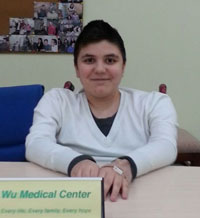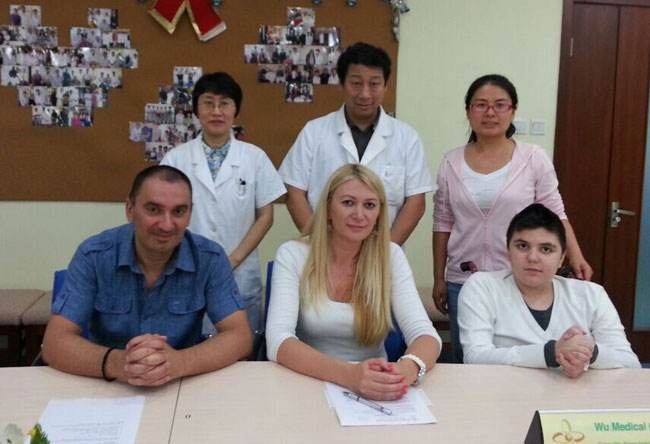Leonid Aritonovski - Duchenne muscular dystrophy (Macedonia) Posted on October 13, 2014
Name: Leonid Aritonovski 
Sex: Male
Country: Macedonia
Age:11 years
Diagnosis: Duchenne muscular dystrophy
Date: September 9, 2014
Days Admitted to Hospital: 21 days
Before treatment:
The patient was found to present with walking gait abnormality when he was 4 years old. Due to weakness in the muscle of the patient, he walked with his toes. He was sent to a local hospital and was diagnosed with duchenne muscular dystrophy. Then the patient received rehabilitation training. With the disease progressed gradually, the weakness of lower limbs was aggravated and the patient suffered from muscle atrophy and damaged pelvic girdle muscle. He falls frequently and was unable to walk. He was kept in wheelchair. About 1 year ago, the patient suffered from weakness of both upper limbs. His upper limbs also suffered from muscle atrophy. He had difficulty to exercise. He received rehabilitation in a local hospital, but the effect was not good. Before the treatment, the patient couldn’t take care of himself. Both lower limbs had paralysis. There was obvious pain when he exercised hip joints and knee joints. He was unable to maintain sitting position. He was unable to turn over, sit- up, stand or walk. There was no cough when he ate. There was no obvious breathing difficulty.
From the onset of disease, the patient had good spirit. The diet and sleep were good. His defecation and urine routine were normal. His weight was high than normal. There was no similar disease in his family.
Nervous System Examination:
Leonid Aritonovski was alert, and his speech was fluent. His spirit was good. His memory, calculation ability, comprehension and orientation were all normal. Both pupils were equal in size and round, the diameter was 3.0mms. Both pupils were sensitive to light stimulus. Both eyeballs had flexible movement. The forehead wrinkle pattern was symmetrical. The ability to close his eyes was normal. The bilateral nasolabial sulcus was equal in depth. The tongue was centered in the oral cavity, with no teeth deflection. There was no air leakage when he drummed his cheeks. He could raise the soft palates strongly. The muscle strength of neck was slightly poor. The muscle strength to shrug his shoulders was weak. The muscle strength of right upper limb’s proximal was at level 3-. The muscle strength of right upper limb's distal end was at level 3. The hold power of both hands was at level 4. The muscle strength of left upper limb's proximal was at level 2+. The muscle strength of left upper limb's distal end was at level 3-. The muscle strength of both lower limbs was between level 0-1. The muscle tone of four limbs was low. The tendon reflex of his four limbs was not elicited. Bilateral achilles tendon reflex was elicited normally. The abdominal reflexes were weaker than normal. Bilateral palm jaw reflex was positive. Bilateral Hoffmman sign, Rossilimo sign and Babinski sign were negative. The deep, shallow sensation and epicritic sensation were normal through primary measure. He was unable to finish the finger-to-nose test, fingers coordination test and the rapid rotation test. He had difficulty with the heel-knee-shin test. There were no signs of meningeal irritation.
Treatment:
We initially gave Leonid Aritonovski a complete medical examination. The patient received treatment for nerve regeneration and to activate stem cells in vivo. He received treatment to promote muscle fiber and nerve regeneration. He received treatment to enhance his liver function, reduce creatase, to nourish the nerves, to nourish muscle and also to stabilize organ function. He also received treatment to improve the blood circulation in order to increase the blood supply to the damaged neurons. This was accompanied with physical rehabilitation treatment.
Post-treatment:
The patient's condition has improved. The creatase level has reduced compared to the time of admission. The muscle strength of waist and back has increased. He is able to sit for 5 minutes. The muscle strength of both upper limbs has increased. The muscle strength of right upper limb's near - end is at level 3 and the muscle strength of right upper limb's far-end is at level 3+. The hold power of right hand is at level 4+. The muscle strength of left upper limb's near - end is at level 3 and the muscle strength of left upper limb's far-end is at level 3+. The hold power of left hand is at level 4. The pain of both lower limbs has been alleviated obviously. The range of motion of joints has increased obviously. The muscle strength of both lower limbs has increased. Both lower limbs can do external rotation and outward turning action. The muscle strength of both lower limbs is between levels 1 to 2.

(Download the Windows Media Player Firefox Plugin if you are using Firefox browser.
To know more,Please read Using the Windows Media Player plugin with Firefox.)
E-mail:
Date:2014-12-17
Dear sir/madam
Hello
Here are the results of blood test Leonid Aritonovski-Macedonia
His condition is better,easier to move the arms and legs.
Regulary receives therapy was given and physical rehabilitation treatment.
Please let us know is his condition thank you.
Best regards
Nina Aritonovska
Date:2015-1-19
Dear sir/madam
Hello
Here are the results of blood test Leonid Aritonovski-Macedonia
His condition is better,easier to move the arms and legs.
Regulary receives therapy was given and physical rehabilitation treatment.
Please let us know is his condition thank you.
Best regards
Nina Aritonovska
